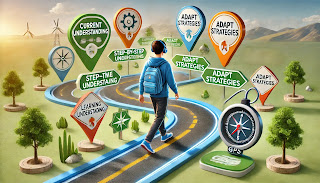The image created by Dall-E
Embracing Authentic Assessment: Bridging the Gap Between Classroom Learning and Real-World Challenges
In today’s rapidly evolving educational landscape, the
concept of authentic assessment has gained significant traction. Unlike
traditional assessments that often focus on rote memorisation and theoretical
knowledge, authentic assessment places students in scenarios that closely mimic
the real-world challenges they will face in their daily lives. This approach enhances
learning and prepares students to apply their knowledge in practical,
meaningful ways. Let’s delve into the critical components of authentic
assessment and explore how it can be effectively implemented in educational
settings.
1. Connecting Learning to Real-World Problems
One of the cornerstones of authentic assessment is its
emphasis on real-world relevance. Individuals are constantly confronted with
complex problems that require critical thinking, problem-solving, and
adaptability. Authentic assessment mirrors these challenges by presenting
students with tasks grounded in everyday scenarios. For instance, instead of
merely solving abstract math problems, students might be asked to budget for a
household or plan a community event, requiring them to apply mathematical
concepts in a practical context.
This real-world connection makes learning more engaging and
helps students see the value of their education. When students understand that
what they are learning directly affects their lives, they are more likely to be
motivated and invested in their studies.
2. Cognitive Challenge and the Gradual Escalation of
Difficulty: The Role of Formative Assessments
In the realm of authentic assessment, formative assessments
play a crucial role in guiding students through a journey of increasing
cognitive challenge. Formative assessments are ongoing checks for understanding
throughout the learning process, providing students and educators with valuable
insights into the learning progress. These assessments are not merely about
gauging what students know at a given moment but are essential tools for
scaffolding learning, building skills incrementally, and fostering more
profound understanding.
The Importance of Formative Assessments
Formative assessments are vital because they allow for
timely intervention and support, helping to ensure that students do not fall
behind as the complexity of tasks increases. They serve as a bridge between
learning and teaching, offering educators the opportunity to adjust instruction
based on student needs and providing students with feedback that is both
immediate and actionable.
Through formative assessments, students can:
- Gauge
Their Understanding: Students can identify areas where they may struggle
and seek clarification or additional practice before moving on to more
complex tasks.
- Build
Confidence: Students can build confidence in their abilities by
starting with more straightforward tasks and gradually progressing to more
challenging ones, which is crucial for tackling higher-level cognitive
challenges.
- Develop
Self-Regulation: Regular formative assessments help students become
more self-aware and self-regulated learners as they learn to monitor their
progress and set improvement goals.
For educators, formative assessments provide:
- Insight
Into Student Learning: Educators can pinpoint students' learning
journeys, identify common misconceptions, and tailor instruction to meet
individual or group needs.
- Opportunities
for Differentiation: Formative assessments allow teachers to
differentiate instruction, offering more support to those who need it and
additional challenges to those who are ready to advance.
- Data
for Informed Instruction: The data gathered from formative assessments
can guide instructional decisions, ensuring that teaching is responsive
and targeted.
Examples of Formative Assessments: Low, Medium, and High
Stakes
Formative assessments can vary in stakes and impact, ranging
from low-stakes activities that serve as simple checks for understanding to
high-stakes tasks that demand deeper cognitive engagement. Let’s explore
examples of formative assessments across this spectrum:
Low-Stakes Formative Assessments:
- Exit
Tickets: At the end of a lesson, students can complete a quick exit
ticket, answering questions or summarising what they learned. This
provides immediate feedback on student comprehension and highlights areas needing
further review.
- Think-Pair-Share:
In this collaborative activity, students first think about a question on
their own, then discuss it with a partner, and finally share their
thoughts with the class. This technique encourages all students to engage
with the material and provides a quick gauge of understanding.
- Quizzes:
Short, low-pressure quizzes can be used to check for understanding key
concepts. These can be graded or ungraded and serve to reinforce learning
and identify areas where students need more practice.
Medium-Stakes Formative Assessments:
- Reflective
Journals: Students can regularly write in journals, reflecting on what
they have learned, how they are progressing, and what challenges they
face. This helps students process their learning and provides educators
with insights into students’ thought processes and understanding.
- Concept
Maps: Students can create concept maps to organise and visually
represent their understanding of a topic. This activity requires students
to make connections between ideas, providing a deeper insight into their
grasp of the subject matter.
- Peer
Assessment: Students review each other’s work using a rubric and
provide feedback based on specific criteria. This helps students develop
evaluative judgment and reinforces their understanding of the content.
High-Stakes Formative Assessments:
- Project-Based
Learning: In project-based learning (PBL), students engage in extended
projects that require applying multiple skills and knowledge areas. As
they work on their projects, formative assessments can be embedded at
various stages, such as during research, design, and implementation. These
assessments might include checkpoints where students must present their
progress or submit portions of their work for review.
- Case
Studies: Students analyse real-world scenarios related to the subject
matter and propose solutions. This type of assessment challenges students
to apply their knowledge in complex, practical situations, offering
opportunities for deep learning and critical thinking.
- Performance
Tasks: In performance tasks, students demonstrate their understanding
through real-world applications, such as presentations, experiments, or
simulations. These tasks are often comprehensive and require students to
integrate knowledge and skills across different areas, making them
high-stakes yet highly informative for both students and educators.
The Gradual Escalation of Difficulty
The key to effectively using formative assessments in
authentic assessment lies in their strategic use to gradually escalate
cognitive challenges. Students start with low-stakes activities that build
foundational knowledge and skills. As they demonstrate mastery, they progress
to medium-stakes tasks that require more complex thinking and application.
Finally, they tackle high-stakes assessments that push them to apply their
learning in real-world contexts.
This progression supports student learning and ensures that
students are continually stretched and challenged, preparing them for the
demands of real-world problem-solving. By carefully designing and sequencing
formative assessments, educators can create a learning environment that
nurtures growth, fosters resilience, and, ultimately, empowers students to
succeed beyond the classroom.
3. Encouraging Evaluative Judgment Through Detailed
Analytic Rubrics
Developing students’ evaluative judgment—the ability to
assess the quality of their work and that of others—is a critical aspect of
authentic assessment. To cultivate this skill effectively, educators must
provide students with detailed analytic rubrics that outline clear criteria for
success. These rubrics serve as a roadmap, guiding students through tasks and
ensuring they understand what is expected of them and how they can succeed.
Detailed Analytic Rubrics: A Roadmap for Success
Analytic rubrics break down tasks into specific components,
each with its criteria and performance levels. This clarity allows students to
understand precisely what is required and how to reach the highest standards.
Involving students in creating or reviewing rubrics deepens their understanding
of the criteria, helping them internalise quality work standards.
Rubrics facilitate self-assessment and peer assessment,
encouraging students to critically evaluate their and others’ work. This
practice reinforces learning and helps students develop the ability to judge
the quality of their work, a skill that is essential for lifelong learning and
professional success.
Integrating Rubrics with Feedback for Maximum Impact
To maximise the effectiveness of rubrics, they should be
closely integrated with the feedback provided throughout the assessment
process:
- Aligning
Feedback with Rubric Criteria: Feedback should directly reference the
rubric criteria, ensuring they are targeted and specific. This helps
students understand how their work aligns with or deviates from the
expected standards.
- Using
Rubrics as a Dialogue Tool: Encourage students to use the rubric for
self-assessment before submitting their work. Post-feedback, they can
compare their self-assessment with the educator’s feedback, fostering a
deeper understanding of their performance.
- Incorporating
Feedback into Revisions: Allow students to revise their work based on
feedback, using the rubric as a guide. This iterative process highlights
the rubric's role in continuously improving their work.
4. The Central Role of Feedback in the Learning Process
Feedback is the cornerstone of authentic assessment. It
provides students with the necessary guidance to improve their work and deepen
their understanding. Different types of feedback serve different purposes, and
when used effectively, they can significantly enhance the learning experience.
Types of Feedback and Their Impact
1. Oral Feedback:
- Characteristics:
Delivered verbally during class, one-on-one, or in group settings.
- Advantages:
It is immediate and adjustable in real time based on student responses,
allowing for dynamic interaction and instant clarification.
- Example:
During a classroom activity, a teacher might say, "Great approach,
but what if you considered this alternative method? How would that change
your outcome?"
2. Audio Feedback:
- Characteristics:
Recorded comments that students can listen to at their convenience.
- Advantages:
Allows for detailed and reflective commentary, ideal for online or
asynchronous environments with limited face-to-face interaction.
- Example:
A teacher might record an audio note discussing the strengths and areas
for improvement in a student's essay, providing personalised feedback that
the student can revisit as needed.
3. Written Feedback:
- Characteristics:
Provided through comments, annotations, or detailed assignment notes.
- Advantages:
It is concrete and reviewable, making it particularly useful for complex
assignments that require careful reflection and revision.
- Example:
On a research paper, a teacher might write, "Your analysis is
insightful, but your conclusion could be stronger with more direct
evidence. Consider revisiting these sections."
4. Peer Feedback:
- Characteristics:
Students evaluate each other’s work using predefined criteria, often
guided by rubrics.
- Advantages:
Fosters a collaborative learning environment and encourages students to
engage deeply with the material by understanding and applying assessment
criteria.
- Example:
During a peer review session, students might exchange essays and use a
rubric to provide constructive feedback on each other's work.
5. Feedforward Feedback:
- Characteristics:
This approach focuses on providing guidance for future tasks, emphasizing
how students can apply feedback to improve in subsequent assignments.
- Advantages:
Shifts the focus from past performance to future improvement, helping
students understand how to grow and succeed in upcoming challenges.
- Example:
An instructor might say, "In your next project, incorporate more
primary sources to enhance your analysis. Also, consider managing your
time more effectively for thorough revision."
6. The Sandwich Approach:
- Characteristics:
Feedback is structured with positive comments at the beginning and end,
with constructive criticism in the middle.
- Advantages:
Balances praise with critique, making feedback more palatable and
encouraging students to embrace constructive criticism while recognising
their strengths.
- Example:
A teacher might say, "Your introduction captures the reader's
attention—great job! The body of your essay could be more persuasive with
additional evidence. Overall, your writing is clear and well-organized,
which is a strong foundation to build on."
Making Feedback Central to the Learning Process
Feedback should be woven into every stage of the learning
process, serving as an ongoing conversation between the student and the
educator. Effective feedback is timely, specific, and actionable, guiding
students to make informed decisions about improving their work.
By employing various feedback methods—oral, audio, written,
peer, and feedforward—educators can cater to different learning styles and
needs, ensuring that all students have the opportunity to grow and succeed. The
sandwich approach, in particular, helps deliver balanced feedback that
motivates students to engage with and act on the feedback they receive.
When feedback is central to the assessment process, it
creates a continuous loop of learning. Students constantly iterate on their
work, develop their skills, and build the confidence needed to tackle
increasingly complex challenges. This ongoing cycle of feedback and revision is
crucial for cultivating the evaluative judgment necessary for success in both
academic and real-world settings.








